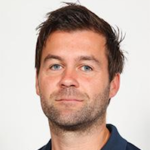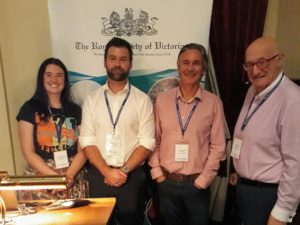The Science (and Art) of Sport
By Catriona Nguyen-Robertson MRSV
RSV Science Communications
This article follows a presentation to the Royal Society of Victoria on 11 April, 2019 titled “Moneyball 2.0: Analytics & Technologies Improving High-Performance Sports” with Associate Professor Sam Robertson (Western Bulldogs & Victoria University) and Professor Damian Farrow (Game Insight Group, Tennis Australia & Victoria University).

The field of sports analytics was thrust into the spotlight by the Michael Lewis book, Moneyball, in 2004. The pressure to apply science to professional sport has accelerated. Associate Professor Sam Robertson and Professor Damian Farrow are dedicated to advancing technologies, data capacities, and analytics to help both professional and recreational athletes.

Growing up in Victoria, Sam was drawn to Australian Rules Football (AFL). He began playing at the age of 14 in school and a local football club before entering the AFL Talent Pathway. He left playing to explore biomechanics and develop innovative performance strategies when he realised that he liked the science side of sport more. He now oversees the sports science partnership between Victoria University and Western Bulldogs as Head of Research and Innovation.
Constantly determining players’ movements in training and competitive games is a non-trivial task. In AFL matches, a number of people usually make calls as to which player has the ball, who they’re passing the ball to, and how far it travels. The information collected by multiple individuals is then sent to central place for validation. Due to the number of people involved, this process is expensive and can be inaccurate. Sam’s solution is to pair GPS tracking with acceleration detection using a device the size of a 50-cent coin. The device can either sit on the ankle or between the shoulder blades to detect exactly where players are on the field and classify their movements (i.e. are they walking, running, kicking, etc.?). Combining this technology with broadcasted visual footage, he developed a mathematical model to determine what options players have possible when they’re in possession of the ball and their probability of kicking a goal. He has brought this technology to the Western Bulldogs so that the team can match their training more closely to what they come across in competition.

Damien was inspired to pursue tennis after he was given the opportunity to hit against elite tennis player, Ken Rosewall. He has since dabbled in a variety of sports, working with a range of Australian Institute of Sport and National sports programs including the AFL, cricket, swimming, surfing, and netball, but has returned to tennis to work behind the scenes. He manages the Game Insight Group (GIG), which is a joint initiative between Tennis Australia and the Institute of Health and Sport at Victoria University.
In collaboration with data scientists and computer engineers, GIG has developed technology and mathematical models that find the best fit tennis racquet for any player and assesses gameplay more accurately. They built a Tennis Lab – an indoor court at Melbourne Park with motion capture system that detects body coordinates and biomechanical information, in addition to the HawkEye system used in competitive tennis to detect ball speed, spins, and trajectory.

The average performance player spends 650 hours practicing with their racquet but only one hour selecting it. 80% of players are not using the equipment that best suits them. With many variables to choose, including the head size, weight, and string pattern, the tennis racquet market is complex with hundreds of options. Damien wanted ‘to get the right racquet in hand of all tennis players with the help of science’ no matter their skill level. He developed a number of products after testing hundreds of players and racquet combinations so that he can now recommend what racquet is best for each individual according to the way they play (or want to play).
The current breakdown of tennis matches also had room for improvement. Tennis statistics (number of winning points, how often a player lands their serves, etc.) don’t tell the full story, as they don’t explain who won a match or why. In the second round Australian Open 2017 match between Novak Djokovic and Denis Istomin, Djokovic won more points as he landed more serves and returned more shots than Istomin, but he lost the match. Damien therefore devised the “clutch performance measure”, in which each point is weighted according to their importance in deciding the winner.

Sam and Damien are also developing ways to use technology in the training process by simulating sporting environments (e.g. interactions with screens and Virtual Reality (VR)). Sam is working towards directly linking the visual experience to decision-making and assessing whether training using VR can be translated to improved sports performance by analysing players’ heart rate responses, footwork, and swing when hitting a virtual ball back. Damien is using cameras to assess players movements to determine how much energy they’re burning up. All players have a maximum limit, and if a player starts to push that limit, they are either fitter than usual… or about to collapse. Assessing player’s work rate (the rate they’re using energy) during games could be used in evaluation, coaching, and match preparation.
There is more data being generated in sport than ever before. With more data and better tools to manage and detect that data, the technology and analysis behind professional and recreational sport will continue to improve, giving players the opportunity to improve alongside them.
- * * * * *
Thanks to Sam and Damian for a wonderful presentation! The video is available to view online from the Society’s Facebook site: https://www.facebook.com/royalsocietyvictoria/videos/2046750602087311/








